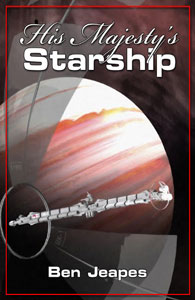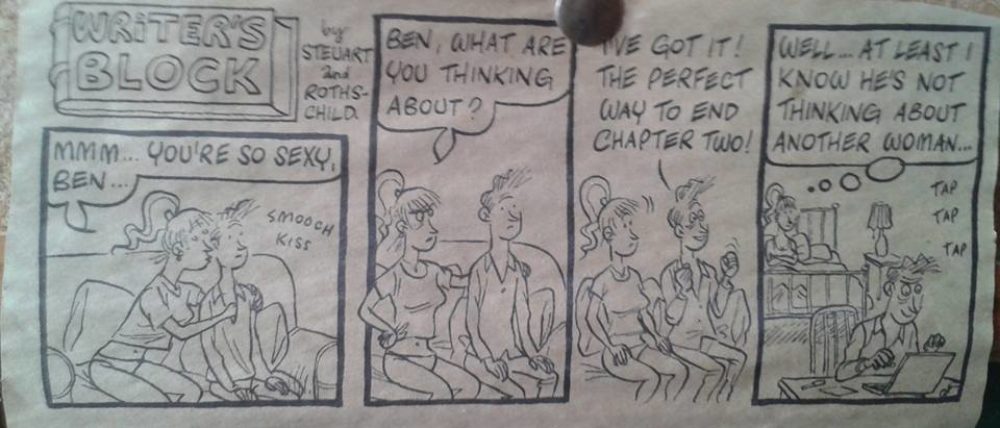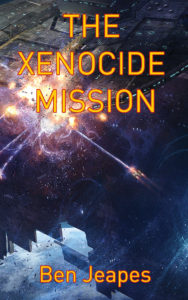
Go to the book’s home page
[I originally wrote this for the twentieth anniversary of publication. It still stands for the twenty fifth. – BJ]
It was twenty years ago today … that His Majesty’s Starship hit the stands. 17 December 1998.
All of which inspires me to reminisce. In the best spirit of present-day science fiction I shall do it in three parts.
In my late teens I read Robert Heinlein’s The Number of the Beast. This proved to be a bad idea because it’s terrible and I couldn’t believe it had been perpetrated by the same author as my beloved Starman Jones, which I read and re-read compulsively up to the age of about 13. However, there is a very brief mention in it of a Royal Space Force. That was an image that hung around in my mind for a long time after, but I didn’t just want to fling it straight into a story as a given. I wanted to know how such a thing had come about.
Also, much as I love good ol’fashioned space opera, with space battles and hyperspace jumps and lasers, I grew up on much more plausible Arthur C. Clarke-type spaceship stories, where there is no artificial gravity and ships must obey the laws of physics. I wanted to write a story that could start in a Clarke-type universe and plausibly end with whizz-bang-splody ships.
In my twenties, I read Hornblower. I had dipped into this before but now at a stroke I read the entire series. I was struck by an aspect of Hornblower that eluded me as a child: his self-loathing. He is a hero and can never believe it. Every mission he undertakes he is convinced will be his last – and this at a time when the English had shot Admiral Byng on his own quarterdeck for messing up. That was my hero!
I almost had a novel.
I didn’t know back then that the phrase ‘Hornblower in space’ was already fast becoming a cliché; I only had a vague idea who Honor Harrington was and David Feintuch’s Hope series had yet to be published. It probably wouldn’t have been a problem if I had, though, because both those others are set well after the start of their respective eras. I wanted to cover the beginning. For example, why exactly would anyone want to arm a spaceship?
I also wanted to bring the limitations of nineteenth century naval warfare to space, as I think the principles will be pretty similar if it ever happens. In Hornblower’s day, ships were big and slow and couldn’t hide. If you were doing five knots and your enemy came over the horizon doing five and a half, then sooner or later there would be a battle, but you could spend all day just looking at your enemy as he crept closer and closer without being able to do a thing about it. There was nowhere to run to, and when the fighting started you just sat there and took it. And so, these principles were applied to the big space battle in the novel, when it came.
Mix ’em all together and I had my background.
Never assume an author is putting himself into his characters, but my hero Michael Gilmore’s Hornbloweresque lack of self-belief certainly mirrored part of my own personality. I began to write His Majesty’s Starship in 1993; I was still in my late twenties and had no idea what the future might hold. I had no idea if I would ever be called upon to lead a large body of people, or even a small one. I did know I didn’t fancy the idea in the slightest because I had no confidence that I could. And so far in my life, I’ve managed to remain a lone wolf.
However, I kicked back slightly against Hornblower’s depressive excesses. Hornblower never really accepts that actually he’s quite good and over time his self-pity becomes actively annoying to the reader. (Well, to me.) Thus by the end of the story Gilmore has good reason to believe he’s actually quite good at what he does.
And the required jump to a Trek-type universe by the end? Okay, I begged the question here: aliens, already technologically advanced, come to Earth with an invitation to the human race to help them develop a world they have available. I called them the First Breed, for reasons which become apparent; the humans nickname them the Rusties. When someone in my writers group said ‘First Breed’ sounded vaguely threatening, hinting at ideas of racial supremacy, I knew I was doing this right.
It took a while to finalise their physical form. At first I played around with all kinds of shapes in my mind but they all came back to the ‘man in a rubber suit’ syndrome; I could take them about as seriously as I could take Trek’s alien of the week. I certainly wasn’t thinking of them as non-human. Then I remembered the Hefn of Judith Moffett’s wonderful (and underrated) Ragged World (tales of the Hefn on Earth – geddit?) series, who are as at home on four feet as they are on two. I put the Rusties on all fours and, voila, aliens!
This also helped me right a grievous wrong that was perpetrated upon science fiction in the early nineties. There was an especially irritating story in Asimov’s called ‘The Nutcracker Coup’. Quite apart from being nauseously cute and upholding the right of all decent Americans to interfere in the affairs of less developed planets if they find the culture un-American or even if they are just plain bored, it featured a four legged intelligent race which – and I gaped with astonishment when I read it – still carried things about in its front legs, so that if one of them was holding a gun on you, say, it hobbled along on three legs while it kept you covered. An interesting take on evolutionary theory, I thought. How would these creatures ever invent the gun? Or any human-type tool that effectively disabled an entire limb if it was going to be used?
Thus, my Rusties had grasping tentacles on either side of their heads which they used the same way we humans used hands.
Other things about them just came off the top of my own head. Rusties appear to human eyes to be flaking rust, hence the name (at first I actually wanted them to be sweating iron oxide, but my biochemistry isn’t up to it), and when they are conversing face to face, humans have to fight the urge to pick the flakes off the alien’s skin. A Rustie’s nostrils are at the top of its domed head, above the eyes – they come from a relatively predator-free stock that evolved on the plains, so need to keep their airways free of dust and dirt – and thus humans tend to make eye contact with the alien’s nose. They communicate very much by body language, managing to transmit whole concepts in an instant with a gesture or a scent that would take a human much longer to say out loud; this meant I had to find a way of writing down a Rustie conversation from a Rustie’s point of view. And they are herd animals, which is very important.
So. Our friendly aliens offer to take a delegation of human ships to a far-off solar system. But the humans haven’t yet discovered how to travel faster than light. So, how is this achieved?
I am indebted to my friends David Angier and Tim Bellerby for what became the step-through process. They know more physics and maths and other clever stuff than I do, so I explained my dilemma:
- I wanted a faster-than-light process.
- It had to be convincing and plausible-sounding, based on our present scientific knowledge and extrapolating suitably (no magic “he pressed the hyperdrive button and the ship shot away …”).
- It had to have limitations.
Let me explain that last point. A ship that can just turn on the warp drive (Star Trek) or leap into hyperspace (Star Wars) has it too easy, and whenever dramatic tension is required, the warp drive or the jump generator fails with monotonous regularity. Far more fun from the writer’s point of view is to have the technology invariably work under the right circumstances, but to make those circumstances hard to attain. For instance, in Babylon 5, the ability to get into hyperspace is never in doubt for anyone who can reach a jumpgate, and never once in the five-year run of the series did a jumpgate malfunction. But, if you are in a small craft like a Starfury, you still have to get there, and anything can happen on the way. Larger ships, which can open their own jump points, have it easier but still are constrained: doing it too near a planet is problematic, and the jump generators always need to recharge (at a consistent rate) before they can be used again.
And my friends came up with step-through. The basics really are based on what we know of quantum theory and wormholes: but as it stood to reason that the inventors of the process, not being human, wouldn’t have called them wormholes, nor do my characters. More contentious, but dramatically interesting, is the contrivance that step-through only works between points of the same gravitational potential, and are easily detectable if you have the right equipment. Again, this introduces limitations that the characters might have to get around in a hurry.
Well, you wouldn’t want it too easy, would you?
Finally, the ship itself: His Majesty’s Starship, HMSS Ark Royal. This was originally Raptor, a pun on Trek’s Bird of Prey, until I decided that the UK probably would call its first starship Ark Royal – and anyway, it pushed up the word count. (Ark Royal‘s landing boat, Sharman, is of course named after the first Brit in space – Helen Sharman.)
Much too much of my motivation for His Majesty’s Starship was wanting to do right what Star Trek did wrong; like, emphasising that my ships have seat belts, and depressurise during battles. At the time, Star Trek was the only viable space-based series on television, other than repeats of the original Battlestar Galactica and Buck Rogers in the 25th Century – both of which could only be loved for their classic cheese status. But then, in 1994, a few thousand words into the first draft of His Majesty’s Starship, Babylon 5 hit our screens and changed everything.


